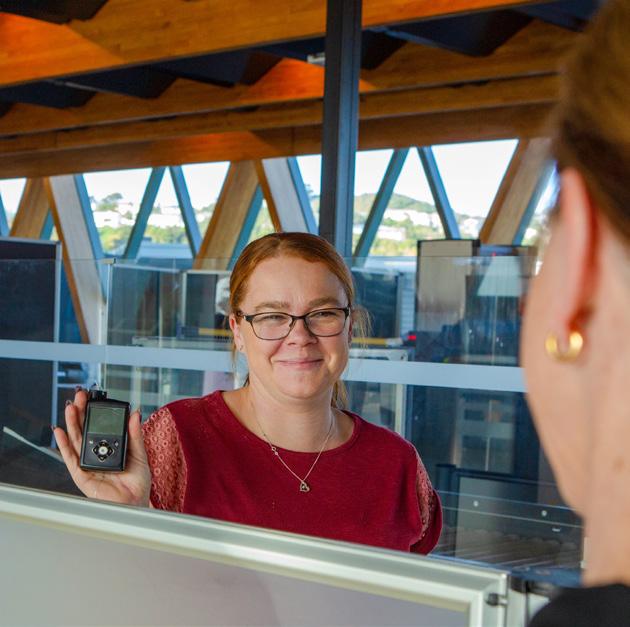
4 minute read
Travelling with tech
The New Zealand Aviation Security Service has joined forces with Diabetes NZ to produce guidance on what to expect at airport security for people living with diabetes.
Security screening at airports can bring uncertainty for travellers with medical conditions due to restrictions on medications, whether screening equipment will impact medical devices, and what happens if an officer needs to inspect a device or other related items.
The New Zealand Aviation Security Service (AvSec) has created an online brochure that aims to educate and prepare people living with diabetes before they arrive at the airport. It explains the screening process and includes relevant tips and helpful information.
The brochure aims to address uncertainty, making the screening process stress-free, and set expectations from the beginning. This guidance comes after Diabetes NZ reached out to AvSec to produce an informative product to support their community.
‘We received feedback from our community that their experience at airport security was not as smooth or as positive as it could be. We approached AvSec to see whether they would work with us on a resource to reassure and educate people travelling with medical devices about what they can expect as they move through our airports.
‘Happily, AvSec were open to a collaboration and have been a fantastic partner throughout the process, taking time to understand the specific situations the diabetes community faces and welcoming our advice,’ said Heather Verry, Chief Executive, Diabetes NZ.
AvSec encourages everyone to communicate openly about their situation with an Aviation Security Officer (ASO) at the earliest opportunity. ASOs are trained to handle a wide range of scenarios that deviate from the standard procedure, including situations involving medical devices.
‘We know security screening can be daunting, particularly for people with medical devices. There’s a common concern about how those devices interact with our equipment,’ says AvSec’s General Manager, Mark Wheeler.
‘Medical devices can pass through the walk-through metal detector. However, they can’t be taken into the body scanners or x-ray machines. Our officers are here to help, and we have procedures to deal with all types of situations.’
For more information about the brochure, please visit bit.ly/AvSec-diabetes

We know security screening can be daunting, particularly for people with medical devices. There’s a common concern about how those devices interact with our equipment… Our officers are here to help, and we have procedures to deal with all types of situations.
MARK WHEELER, GENERAL MANAGER, AVSEC
GUIDANCE FOR TRAVELLERS WITH DIABETES
If you’re travelling internationally, please be aware that advice may vary for other countries due to different procedures and equipment in use. Please contact your airline or the relevant screening authority in each country where you’ll pass through security screening.
TECH PREP FOR TRAVEL
Advice from Diabetes NZ:
• Know your device: check your device’s user manual for specific travel instructions. Different brands may have different procedures.
• Doctor’s note and ID: carry a doctor’s letter stating that you have diabetes and the devices you depend on. A medical ID bracelet is also helpful to wear, if you have one.
• Pack spares: bring extra sensors, transmitters, and batteries to handle unexpected situations.
• Inform your airline: some airlines require notification for in-flight medical needs. Check their guidelines well in advance.
GENERAL ADVICE FOR SAFE TRAVEL
• Always carry essential supplies and insulin on you and carry twice the quantity you would usually take.
• To avoid your insulin freezing, pack it in your carry-on luggage. Don’t expose it to extremes of temperature. If necessary, carry it in an insulated bag.
• If you use an insulin pump or CGM, follow the manufacturer's guidelines for flying.
• Always obtain medical insurance when travelling.
• Check your blood glucose frequently while travelling.
• Carry a hypo management kit, including follow-up carbs, and keep it in the seat pocket so you can reach it when you are not allowed to leave your seat.
• Check the strength of any insulin you get overseas, as some countries market different strength insulin.
www.diabetes.org.nz/managing-diabetes-travelling-2
When you approach the screening point, please inform an Aviation Security Officer at the earliest opportunity if you have a wireless medical device, such as an insulin pump or Continuous Glucose Monitor. They can arrange an alternative screening procedure for you.
For more in-depth information on travelling with diabetes, please head to bit.ly/AvSec-diabetes










